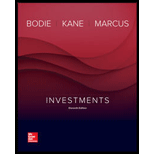
a.
To compute: The five year spot and forward rates with annual compounding.
Introduction:
Yield-curve analysis is a technique to calculate the difference in interest rate between the note value and the term of to maturity. Yield curve analysis is the comparison of yields between issuers and it may vary by term to maturity.
b.
To explain: The concept of short rate, spot rate and forward rate and evaluate the relationship between them.
Introduction:
Yield-curve analysis is a technique to calculate the difference in interest rate between the note value and the term of to maturity. Yield curve analysis is the comparison of yields between issuers and it may vary by term to maturity.
c.
To compute: The expected yield to maturity and the price for the security.
Introduction:
Yield-curve analysis is a technique to calculate the difference in interest rate between the note value and the term of to maturity. Yield curve analysis is the comparison of yields between issuers and it may vary by term to maturity.
Trending nowThis is a popular solution!

Chapter 15 Solutions
Investments
- Finance question. None please listen if you deslike my answer i will give your. Also if you will give more deslike bartleby site will be shut down.arrow_forwardCorrect solnarrow_forwardplease listen if you deslike my answer i will give in your answer. Bartleby also changed the rule for this change we all are responsible so please don't do this. Also if we will give more deslike bartleby site will be shut down.arrow_forward
- Muskoka Tourism has announced a rights offer to raise $30 million for a new magazine, titled ‘Discover Muskoka’. The magazine will review potential articles after the author pays a nonrefundable reviewing fee of $5,000 per page. The stock currently sells for $52 per share and there are 3.9 million shares outstanding. Required What is the maximum possible subscription price? What is the minimum? If the subscription price is set at $46 per share, how many shares must be sold? How many rights will it take to buy one share? What is the ex-rights price? What is the value of a right?arrow_forwardNorthern Escapes Inc. has 225,000 shares of stock outstanding. Each share is worth $73, so the company’s market value of equity is $16,425,000. Suppose the firm issues 30,000 new shares at the following prices: $73, $69, and $60. What will the effect be of each of these alternative offering prices on the existing price per share?arrow_forwardNeed answer correctly.arrow_forward
 EBK CONTEMPORARY FINANCIAL MANAGEMENTFinanceISBN:9781337514835Author:MOYERPublisher:CENGAGE LEARNING - CONSIGNMENT
EBK CONTEMPORARY FINANCIAL MANAGEMENTFinanceISBN:9781337514835Author:MOYERPublisher:CENGAGE LEARNING - CONSIGNMENT

